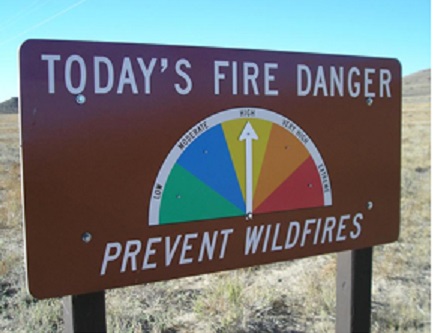Ever been driving along a highway, spotted a Fire Danger Sign, and wondered what it is truly indicating?
Fire Danger is a description of the combination of both constant and variable factors that affect the initiation, spread, and difficulty to control a wildfire in a given area. There are many systems and schemes that attempt to provide accurate and reliable predictions of fire danger, that analyze the fuel, topography, and weather, and integrate their effects into a set of numbers that fire managers can use to determine a rating.

Since 1974, five rating levels have been used to describe danger levels in public information releases and fire prevention signing:
Low (Green) – Fire starts are unlikely. Weather and fuel conditions will lead to slow fire spread, low intensity and relatively easy control with light mop-up. Controlled burns can usually be executed with reasonable safety.
Moderate (Blue) – Some wildfires may be expected. Expect moderate flame length and rate of spread. Control is usually not difficult and light to moderate mop-up can be expected. Although controlled burning can be done without creating a hazard, routine caution should be taken.
High (Yellow) – Wildfires are likely. Fires in heavy, continuous fuel such as mature grassland, weed fields and forest litter, will be difficult to control under windy conditions. Control through direct attack may be difficult but possible and mop-up will be required. Outdoor burning should be restricted to early morning and late evening hours.
Very High (Orange) – Fires start easily from all causes and may spread faster than suppression resources can travel. Flame lengths will be long with high intensity, making control very difficult. Both suppression and mop-up will require an extended and very thorough effort. Outdoor burning is not recommended.
Extreme (Red) – Fires will start and spread rapidly. Every fire start has the potential to become large. Expect extreme, erratic fire behavior. NO OUTDOOR BURNING SHOULD TAKE PLACE IN AREAS WITH EXTREME FIRE DANGER.
– See more at: http://www.nps.gov/fire/wildland-fire/learning-center/fire-in-depth/understanding-fire-danger.cfm#sthash.qf9PGgN8.dpuf
![]()



